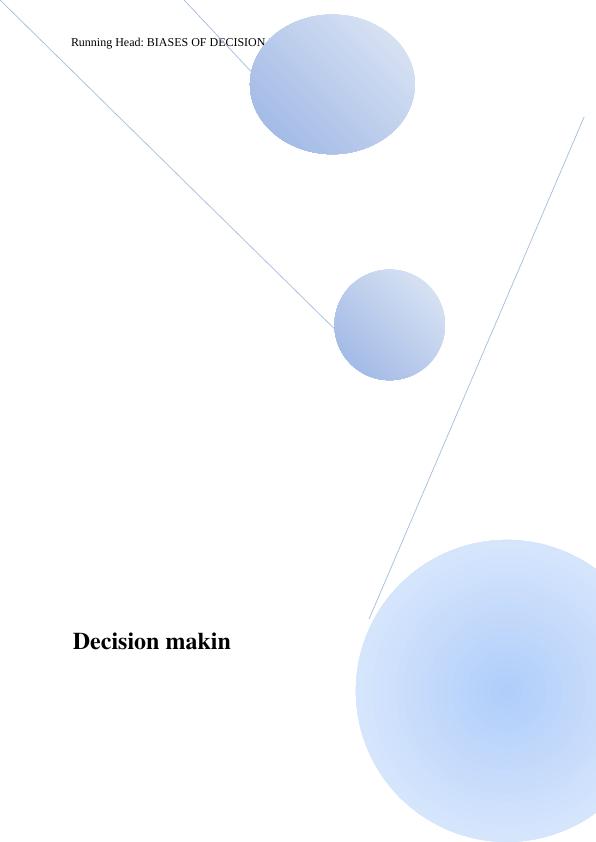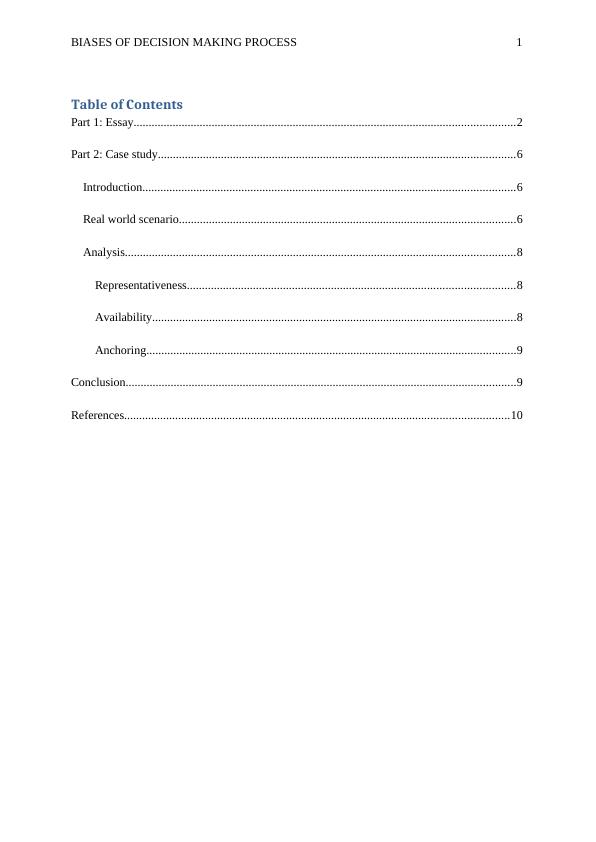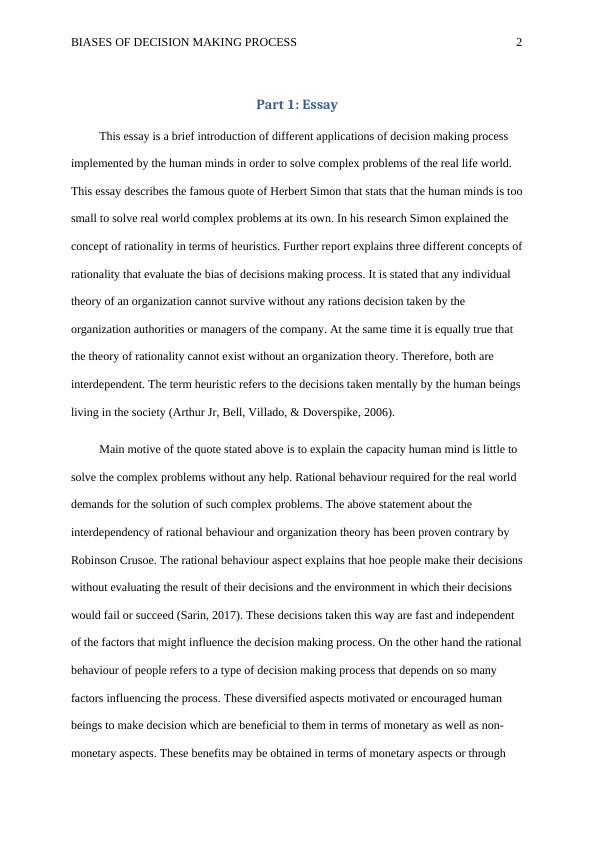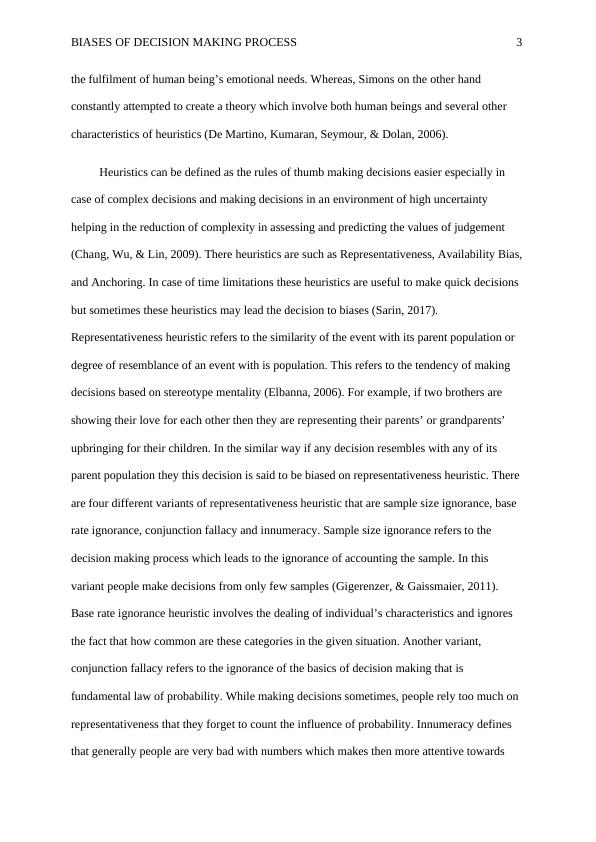Biases of Decision Making Process
Added on 2023-06-11
12 Pages2861 Words272 Views
Running Head: BIASES OF DECISION MAKING PROCESS
Australia
6/8/2018
Australia
6/8/2018

BIASES OF DECISION MAKING PROCESS 1
Table of Contents
Part 1: Essay...............................................................................................................................2
Part 2: Case study.......................................................................................................................6
Introduction............................................................................................................................6
Real world scenario................................................................................................................6
Analysis..................................................................................................................................8
Representativeness.............................................................................................................8
Availability.........................................................................................................................8
Anchoring...........................................................................................................................9
Conclusion..................................................................................................................................9
References................................................................................................................................10
Table of Contents
Part 1: Essay...............................................................................................................................2
Part 2: Case study.......................................................................................................................6
Introduction............................................................................................................................6
Real world scenario................................................................................................................6
Analysis..................................................................................................................................8
Representativeness.............................................................................................................8
Availability.........................................................................................................................8
Anchoring...........................................................................................................................9
Conclusion..................................................................................................................................9
References................................................................................................................................10

BIASES OF DECISION MAKING PROCESS 2
Part 1: Essay
This essay is a brief introduction of different applications of decision making process
implemented by the human minds in order to solve complex problems of the real life world.
This essay describes the famous quote of Herbert Simon that stats that the human minds is too
small to solve real world complex problems at its own. In his research Simon explained the
concept of rationality in terms of heuristics. Further report explains three different concepts of
rationality that evaluate the bias of decisions making process. It is stated that any individual
theory of an organization cannot survive without any rations decision taken by the
organization authorities or managers of the company. At the same time it is equally true that
the theory of rationality cannot exist without an organization theory. Therefore, both are
interdependent. The term heuristic refers to the decisions taken mentally by the human beings
living in the society (Arthur Jr, Bell, Villado, & Doverspike, 2006).
Main motive of the quote stated above is to explain the capacity human mind is little to
solve the complex problems without any help. Rational behaviour required for the real world
demands for the solution of such complex problems. The above statement about the
interdependency of rational behaviour and organization theory has been proven contrary by
Robinson Crusoe. The rational behaviour aspect explains that hoe people make their decisions
without evaluating the result of their decisions and the environment in which their decisions
would fail or succeed (Sarin, 2017). These decisions taken this way are fast and independent
of the factors that might influence the decision making process. On the other hand the rational
behaviour of people refers to a type of decision making process that depends on so many
factors influencing the process. These diversified aspects motivated or encouraged human
beings to make decision which are beneficial to them in terms of monetary as well as non-
monetary aspects. These benefits may be obtained in terms of monetary aspects or through
Part 1: Essay
This essay is a brief introduction of different applications of decision making process
implemented by the human minds in order to solve complex problems of the real life world.
This essay describes the famous quote of Herbert Simon that stats that the human minds is too
small to solve real world complex problems at its own. In his research Simon explained the
concept of rationality in terms of heuristics. Further report explains three different concepts of
rationality that evaluate the bias of decisions making process. It is stated that any individual
theory of an organization cannot survive without any rations decision taken by the
organization authorities or managers of the company. At the same time it is equally true that
the theory of rationality cannot exist without an organization theory. Therefore, both are
interdependent. The term heuristic refers to the decisions taken mentally by the human beings
living in the society (Arthur Jr, Bell, Villado, & Doverspike, 2006).
Main motive of the quote stated above is to explain the capacity human mind is little to
solve the complex problems without any help. Rational behaviour required for the real world
demands for the solution of such complex problems. The above statement about the
interdependency of rational behaviour and organization theory has been proven contrary by
Robinson Crusoe. The rational behaviour aspect explains that hoe people make their decisions
without evaluating the result of their decisions and the environment in which their decisions
would fail or succeed (Sarin, 2017). These decisions taken this way are fast and independent
of the factors that might influence the decision making process. On the other hand the rational
behaviour of people refers to a type of decision making process that depends on so many
factors influencing the process. These diversified aspects motivated or encouraged human
beings to make decision which are beneficial to them in terms of monetary as well as non-
monetary aspects. These benefits may be obtained in terms of monetary aspects or through

BIASES OF DECISION MAKING PROCESS 3
the fulfilment of human being’s emotional needs. Whereas, Simons on the other hand
constantly attempted to create a theory which involve both human beings and several other
characteristics of heuristics (De Martino, Kumaran, Seymour, & Dolan, 2006).
Heuristics can be defined as the rules of thumb making decisions easier especially in
case of complex decisions and making decisions in an environment of high uncertainty
helping in the reduction of complexity in assessing and predicting the values of judgement
(Chang, Wu, & Lin, 2009). There heuristics are such as Representativeness, Availability Bias,
and Anchoring. In case of time limitations these heuristics are useful to make quick decisions
but sometimes these heuristics may lead the decision to biases (Sarin, 2017).
Representativeness heuristic refers to the similarity of the event with its parent population or
degree of resemblance of an event with is population. This refers to the tendency of making
decisions based on stereotype mentality (Elbanna, 2006). For example, if two brothers are
showing their love for each other then they are representing their parents’ or grandparents’
upbringing for their children. In the similar way if any decision resembles with any of its
parent population they this decision is said to be biased on representativeness heuristic. There
are four different variants of representativeness heuristic that are sample size ignorance, base
rate ignorance, conjunction fallacy and innumeracy. Sample size ignorance refers to the
decision making process which leads to the ignorance of accounting the sample. In this
variant people make decisions from only few samples (Gigerenzer, & Gaissmaier, 2011).
Base rate ignorance heuristic involves the dealing of individual’s characteristics and ignores
the fact that how common are these categories in the given situation. Another variant,
conjunction fallacy refers to the ignorance of the basics of decision making that is
fundamental law of probability. While making decisions sometimes, people rely too much on
representativeness that they forget to count the influence of probability. Innumeracy defines
that generally people are very bad with numbers which makes then more attentive towards
the fulfilment of human being’s emotional needs. Whereas, Simons on the other hand
constantly attempted to create a theory which involve both human beings and several other
characteristics of heuristics (De Martino, Kumaran, Seymour, & Dolan, 2006).
Heuristics can be defined as the rules of thumb making decisions easier especially in
case of complex decisions and making decisions in an environment of high uncertainty
helping in the reduction of complexity in assessing and predicting the values of judgement
(Chang, Wu, & Lin, 2009). There heuristics are such as Representativeness, Availability Bias,
and Anchoring. In case of time limitations these heuristics are useful to make quick decisions
but sometimes these heuristics may lead the decision to biases (Sarin, 2017).
Representativeness heuristic refers to the similarity of the event with its parent population or
degree of resemblance of an event with is population. This refers to the tendency of making
decisions based on stereotype mentality (Elbanna, 2006). For example, if two brothers are
showing their love for each other then they are representing their parents’ or grandparents’
upbringing for their children. In the similar way if any decision resembles with any of its
parent population they this decision is said to be biased on representativeness heuristic. There
are four different variants of representativeness heuristic that are sample size ignorance, base
rate ignorance, conjunction fallacy and innumeracy. Sample size ignorance refers to the
decision making process which leads to the ignorance of accounting the sample. In this
variant people make decisions from only few samples (Gigerenzer, & Gaissmaier, 2011).
Base rate ignorance heuristic involves the dealing of individual’s characteristics and ignores
the fact that how common are these categories in the given situation. Another variant,
conjunction fallacy refers to the ignorance of the basics of decision making that is
fundamental law of probability. While making decisions sometimes, people rely too much on
representativeness that they forget to count the influence of probability. Innumeracy defines
that generally people are very bad with numbers which makes then more attentive towards

End of preview
Want to access all the pages? Upload your documents or become a member.
Related Documents
Master of Business Administration: Decision Making Process and Heuristicslg...
|16
|4948
|404
Explaining Biases in Decision Making (Doc)lg...
|16
|4788
|76
Decision-Making in the Real World Assignment PDFlg...
|16
|3897
|46
Heuristics and Bias in Decision Making: Analysis of Human Mind's Capabilitylg...
|10
|1298
|121
Managerial decision-makinglg...
|10
|2190
|317
Managerial Decision Making: Critical Examination of Simon’s Quotelg...
|11
|2192
|174